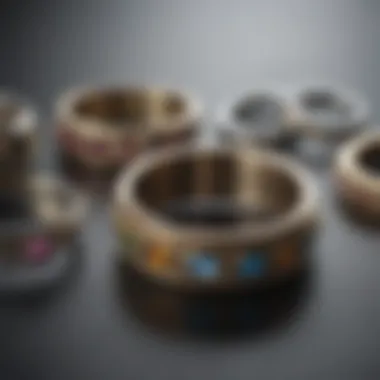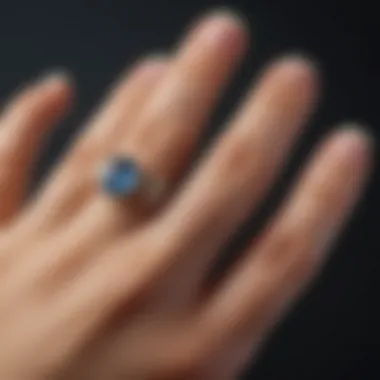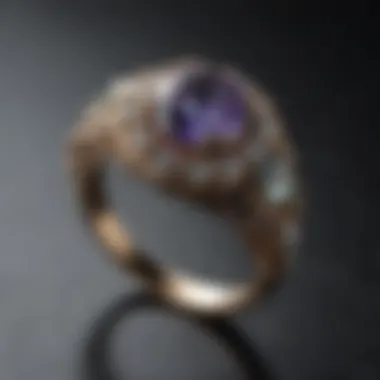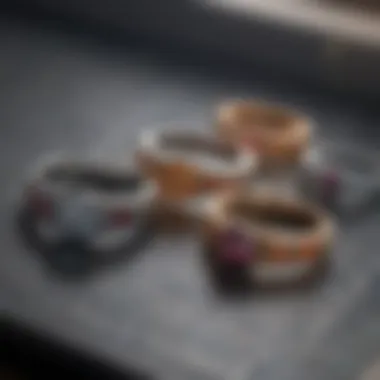Determining Your Ring Size: A Comprehensive Guide


Intro
Getting the right ring size can be a daunting task for many. Imagine finding the perfect ring, only to realize it doesn't fit. It’s like trying to put a square peg in a round hole. Whether you are shopping for yourself, purchasing a gift, or designing a custom piece, understanding your ring size is essential.
In this guide, we will walk you through various methods, tools, and techniques for accurately determining your ring size. We'll explore the common myths surrounding ring sizes, delve into the factors that influence sizing, and provide practical tips to ensure a comfortable and secure fit.
Whether you're just dipping your toes into the world of jewelry or you've been around the block a few times, this guide is designed to cater to your needs. So, let's roll up our sleeves and get started on figuring out that ring size!
Understanding Ring Sizes
Determining your ring size can seem like a simple task, but it’s a crucial step that holds significant weight in the world of jewelry. Getting the right size ensures comfort and prevents the unwelcome scenario of a ring that’s either too tight or too slack. Ring sizes vary not only geographically, but between different styles and designs; some factors can make a size fit differently based on personal characteristics such as body temperature and even the time of day.
Basics of Ring Sizes
At the core, every ring size is measured on a common scale. In many parts of the world, the standard system is based on diameter or circumference of the ring, often designated by whole numbers or fractions. For instance, in the United States, the sizing may go from size 3 to size 15, with half sizes in between. In contrast, other regions, such as Europe, use a numeric system based on millimeters. For example, if you were to try on a size 54 ring, that number corresponds to the inner circumference in millimeters.
Here are some key points to remember when thinking about ring sizes:
- Measurement Methods: Rings can be sorted into various sizes depending on how they are measured.
- Consistency: Even specific brands may have slight variations in their sizing, so it’s wise to check their individual guides.
- Cultural Differences: Size representations can change from one region to another, affecting purchases made in different countries.
Importance of Accurate Sizing
Accurate sizing is not just a nicety; it’s a necessity, particularly when making a meaningful purchase such as an engagement ring or a family heirloom. An ill-fitting ring can lead to discomfort, loss, or even regret, whether it’s a casual piece or a statement creation. When considering sizing, keep these aspects in mind:
- Comfort: A snug fit often provides the best comfort, making it less likely to slip off or pinch.
- Aesthetics: The way a ring fits can also influence its overall look. A ring that sits lower than expected can distort its design and impact how light plays off it.
- Future Adaptations: Remember, people’s fingers can fluctuate in size due to various factors such as weather or weight changes; an accurate size is a foundational step toward ensuring longevity in wear.
“A well-fitted ring doesn’t just sit on the finger; it becomes a seamless part of the wearer's identity.”
When selecting or resizing a ring, being mindful of accuracy can save one from heartache down the line. Taking the time to understand the nuances of sizing can enrich your jewelry experience and ensure your prized pieces are always a perfect fit.
Common Methods to Determine Ring Size
Determining your ring size can feel like trying to crack a code sometimes. Getting it right is crucial because a ring that’s too loose might take an unwanted unintended journey down the drain, while a snug fit could cause discomfort that lingers. This section digs into the different methods available for determining ring size. Each method has its advantages and it's essential to choose one that suits your personal preference and situation.
Using a Ring Sizer Tool
The ring sizer tool is a straightforward option for those looking to measure their size accurately. These tools generally come in two forms: a set of rings or a plastic measuring tape specifically designed for rings.
- Advantages of using a ring sizer:
- Precision: These tools provide a more accurate measurement than other methods, as they are specifically constructed for this purpose.
- Convenience: Many jewelry stores offer ring sizer tools for free or a nominal fee. Plus, you can order one online for home use.


By sliding the different sizes onto your finger, you can quickly pinpoint which size feels just right. Some tools even feature size markings for both US and European measurements, making it easier to compare different systems. It’s a surefire way to eliminate any guesswork which is essential when investing in fine jewelry.
Measuring with String or Paper
For those who prefer a makeshift solution or don’t have access to a ring sizer, using string or paper can be an effective alternative. While it might not be the most polished approach, it often yields satisfactory results when done correctly.
Here's how to do it:
- Cut a piece of string or paper about 6 inches long.
- Wrap it around the widest part of your finger. Make sure it’s snug but not too tight.
- Mark the point where the string or paper overlaps.
- Measure the length of the string or paper from the start to your mark using a ruler.
- Keep in mind:
- Thin versus Thick Rings: If the ring you are buying is wider, consider going up a half size. Wider bands can feel tighter when compared to narrower ones.
- Variations in Circumference: It is often helpful to repeat the process a couple of times to ensure consistency in your measurements.
Visiting a Jeweler
If precision is paramount or if you already have a specific piece in mind, visiting a jeweler might be the best route to take. Jewelers have the experience and tools necessary to measure your ring size accurately.
- Benefits of seeing a jeweler:
- Expert knowledge: Jewelry professionals are well-versed in different sizes, styles, and customs, ensuring that they can provide guidance tailored to your needs.
- Immediate results: Unlike online solutions, a jeweler can give you your size right away, allowing you to make informed decisions on the spot.
Most jewelers will not charge for this service, and it allows for a personal touch. It’s an opportunity to discuss the type of ring you are interested in while receiving accurate sizing.
In the world of jewelry, an accurate ring size isn’t just a measurement; it’s a key to comfort and style.
Finding the Right Fit
Getting the right fit for a ring is akin to finding the right shoe size; it's not just about looks but also comfort. A ring that fits poorly can slide off easily or pinch your finger, making it far from enjoyable to wear. When looking for the ideal fit, there are a few key considerations that play a significant role in ensuring that your ring serves both style and practicality.
Considering Knuckle Size
One of the foremost factors in determining ring size is the size of your knuckles. Often, fingers can be slender at the base but wider around the knuckle. When measuring, it’s essential to account for this discrepancy. If you take a measurement around the base but your knuckle is comparatively thicker, you might end up with a ring that just won't fit. In essence, when measuring your ring size, try moving the tape or string over your knuckle to see if it slides on easily but not so much that it becomes loose.
For some folks, rings tend to fit comfortably at the knuckle rather than the base. Therefore, it’s wise to choose a size that considers both the base and the knuckle. This way, you’re less likely to get caught in an awkward situation when sliding the ring on or off.
Avoiding Size Discrepancies
Size discrepancies are common but can often be avoided by taking careful and thoughtful measurements. When buying a ring, you don’t want to spoil the surprise with a size that just doesn’t cut it. To eliminate potential issues, consider measuring at various times of the day. Fingers tend to swell due to heat or physical activity, which could lead you to choose a larger size than necessary.
- Measure multiple times: Take measurements on different days to find an average.
- Account for movement: Active lifestyles may require some flexibility in sizing.
By being mindful of these aspects, you can avoid the headache of exchanging or struggling with the fit later on. Keep in mind that even the best measurements are sometimes off by a size or half-size, so knowing the nuances can save you time and hassle.


Evaluating Ring Width
The width of a ring is another factor that affects how it sits on your finger. A wider band tends to feel tighter compared to a narrower band of the same size due to the surface area it covers. If you're leaning toward a chunky design, it might be wise to order a half size up. Conversely, thinner bands generally offer more wiggle room.
For example:
- Wide bands (typically 6 mm and above): Might necessitate a larger size to feel comfortable.
- Narrow bands (less than 4 mm): Often fit snugly with a regular size.
It’s essential to try on different styles to gauge not just the size, but how the width affects your overall comfort. Ultimately, the right fit will not only look good but also feel seamless—just like a ring should.
"The best fit is more than a number; it’s a feeling. When the ring hugs your finger perfectly, you know you've found it."
Taking these nuanced factors into account while finding the right fit will ensure you can wear your ring with confidence and ease, making your jewelry experience much more enjoyable.
Myths and Misconceptions
Understanding the myths and misconceptions around ring sizing is crucial for anyone wanting to find that perfect fit. It's all too easy to fall for popular beliefs that simply don’t hold water. Misunderstandings can lead to frustration, wasted time, and even financial expenses on resizing or replacing rings. Clarifying these points not only helps in choosing the right size but also educates consumers about jewelry making and the factors influencing sizing decisions.
Size and Band Material
One common misconception is that the material of the band significantly alters the size itself. People often believe that a thicker band will always require a larger size. Not quite. While a thicker band may feel tighter due to the way it sits on your finger, it doesn't change the actual measured size of the ring. Different materials can impact how a ring feels on your finger. For instance, a platinum or gold band may feel more substantial compared to a lightweight silver band, even if they are both the same size.
Thus, if your heart is set on a wider band, it's a good idea to try a ring in that style before committing. Don't shy away from asking jewelers for recommendations; they usually have great insights based on your finger size and desired style.
Time of Day and Temperature Influence
Another prevailing myth suggests that the time of day and temperature can influence your ring size. Some folks insist that rings should only be sized during the cooler hours of the day. True, our bodies can expand and contract based on temperature; however, there's no one-size-fits-all approach here. Sizing should ideally be done when your fingers are at a normal state, without extreme conditions affecting their size.
Hot weather often makes fingers swell, while cold temperatures may shrink them. Thus, if you’re measuring at a hot summer picnic, the size you find might not reflect your actual size during a brisk winter walk.
To summarize:
- Consider the material of your band before deciding on a size, as it doesn't dictate measurement but affects comfort.
- Choose a consistent time to measure your rings, when temperatures are moderate, giving you a more accurate sizing.
"The right size isn’t just about the number; it’s about feeling comfortable and confident wearing it, regardless of the material or the outside conditions."
To truly understand your unique fit, place these myths aside and approach sizing with informed skepticism.
These insights will empower you to make smarter decisions, making the jewelry experience much more enjoyable.
Calculating Your Size at Home


Determining your ring size from the comfort of your own space is not only practical but also fosters a greater sense of empowerment for those delving into the world of jewelry. Understanding how to measure your ring size at home allows you to bypass potential discomfort involved in visits to jewelers or inaccuracies from using poor quality tools. With some basic materials, anyone can arrive at an accurate measurement that suits their needs very well.
One significant benefit of measuring at home is flexibility. You can take your time, repeat the process for accuracy, and most importantly, create an environment where you feel less rushed. Additionally, there is no need for a jeweler’s assistance, which may come with added costs or pressures. Measuring your own size at home also allows you to recollect measurements at different times, especially if you experience fluctuations in your body size.
Using Online Ring Size Charts
Online ring size charts can be a reliable resource when trying to find your correct size. They provide a visual guideline that can simplify the measurement process, often eliminating confusion that may arise during manual measurements. Typically, these charts consist of a series of circles representing various sizes, allowing you to compare your own ring to the sizes indicated.
When employing an online chart, it’s crucial to be precise. Here are a few steps to maximize accuracy:
- Select a ring that fits well: Use a ring that you already own and is comfortable. Make sure it matches the finger for which you are measuring.
- Measure the inside diameter: Align your ring with the circles on the chart. The point at which the inside edge of your ring matches up is your size.
- Consider variations across brands: Some manufacturers might have slightly different sizing standards.
Having a reliable way to measure size at home can significantly affect purchasing enjoyment, especially for those shopping online.
Conversion Between Different Measurement Systems
In the world of jewelry, there is a hodgepodge of sizes and measuring systems. Understanding how to navigate through different sizing conventions can seem like hunting for a needle in a haystack. Generally, sizes differ between countries, with some using the numerical system (as in the US) while others may use alphabetical sizing for rings.
To convert sizes effectively, it’s recommended to do the following:
- Research common size conversions: There are tables available that outline size equivalents for various systems. For example, a US size 7 is approximately a UK size N.
- Keep a conversion chart handy: When you find a ring you like while shopping, it’s smart to refer to a chart for a quick size check.
- Use a reputable conversion calculator: Many online platforms offer conversion tools that can save you the headache of figuring out sizes manually.
Knowing how to convert ring sizes can save time and prevent mishaps when ordering rings from different regions.
Understanding how to calculate your size at home, utilize online charts, and convert between systems gives you the knowledge to make informed decisions when purchasing rings. It streamlines the process, allowing gemstone enthusiasts, collectors, and jewelry designers to focus on their passion without the hassle of sizing errors.
Closure and Practical Tips
Determining your ring size is not merely an exercise in measuring your finger. It’s an essential part of ensuring that the piece of jewelry you select—be it an engagement ring, a gift for someone special, or even a fashion accessory—fits perfectly and enhances your personal style. In this comprehensive exploration, we’ve looked at various methods to discern your size, the pitfalls of misjudgment, and the crucial aspects to consider.
Maintaining an Accurate Measurement
A consistent approach to measuring your finger size is vital. Here are a few practical steps to keep you on track:
- Repeat Measurements: It’s advisable to take several measurements over a few days, especially if your fingers tend to swell or shrink, as could be the case due to temperature changes or physical activity.
- Time of Day Matters: Most people find that their fingers are smaller in the morning and larger in the evening. Try to measure at the same time each day for uniformity.
- Use Quality Tools: If you’re using a string or paper, ensure it’s measured accurately with a ruler. For those who appreciate precision, consider investing in a good-quality ring sizer for the best results.
To really nail down your size, store this information securely so you can return to it whenever you’re contemplating a new purchase.
Revisiting Size After Weight Changes
Our bodies are in constant flux; weight fluctuations can significantly affect how rings fit.
Key considerations include:
- Post-Weight Loss or Gain: After significant changes in weight, your ring size may also change. It’s wise to reassess your measurements to avoid the frustration of a ring that no longer fits comfortably.
- Seasonal Changes: Interestingly, some people find that their fingers swell during warm months when circulation increases and contract during colder weather. This makes it worthwhile to have your size checked regularly, particularly before significant purchases.
- Professional Guidance: When in doubt, seek the advice of a jeweler. They can provide a professional measurement and guidance tailored to your unique finger structure.
Remember: Keeping your finger size consistent with your body changes leads to a much more enjoyable jewelery wearing experience.
By incorporating these practical tips and being mindful of changes in your body, you control the variables that impact your ring fit. Bearing in mind that a ring does not just symbolize a promise or occasion, it’s also an expression of personal style. Taking the time to find the perfect size makes for a more fulfilling ownership over the years.







